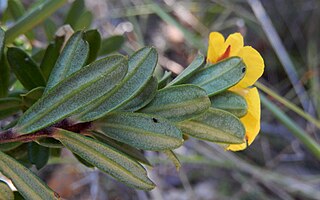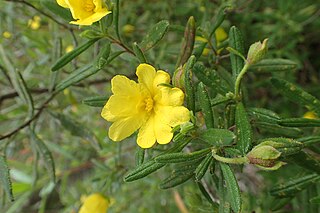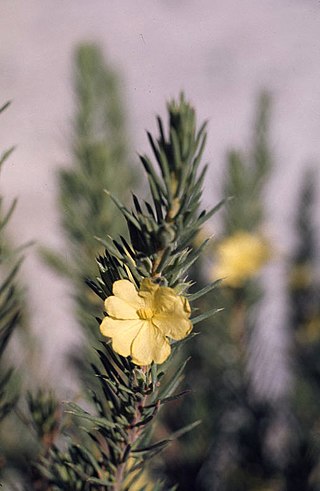
Hibbertia empetrifolia, commonly known as trailing guinea-flower, is a species of flowering plant in the family Dilleniaceae and is endemic to south-eastern Australia. It is a low-lying to spreading shrub with wiry stems, oblong to lance-shaped leaves with the narrower end towards the base, and pale to bright yellow flowers arranged on the ends of branchlets, with five to nine stamens arranged on one side of the two carpels.

Hibbertia vestita, commonly known as hairy guinea-flower, is a species of flowering plant in the family Dilleniaceae and is endemic to eastern Australia. It is a small shrub with foliage covered with simple hairs, usually linear leaves, and yellow flowers with 22 to 43 stamens with many staminodes arranged around three hairy carpels.
Hibbertia marginata, commonly known as bordered guinea flower, is a species of flowering plant in the family Dilleniaceae and is endemic to the North Coast of New South Wales. It is a spreading shrub with hairy young branches, oblong to lance-shaped leaves and yellow flowers with thirty to forty stamens and many staminodes arranged around three hairy carpels.

Hibbertia bracteata is a species of flowering plant, in the family Dilleniaceae, and is endemic to eastern New South Wales. It is a shrub with lance-shaped to oblong leaves and yellow flowers with about sixteen stamens arranged on one side of the two carpels.
Hibbertia banksii is a species of flowering plant in the family Dilleniaceae and is native to Queensland and New Guinea. It is a shrub with thick, leathery leaves and yellow flowers with about twenty to forty-eight stamens arranged on one side of the two carpels.
Hibbertia demissa is a species of flowering plant in the family Dilleniaceae and is endemic to a restricted area of New South Wales. It is a low-lying shrublet with small elliptic leaves and single yellow flowers arranged on the ends of branchlets, with nine to twelve stamens arranged around three carpels.

Hibbertia dispar is a species of flowering plant in the family Dilleniaceae and is endemic to eastern Australia. It is a prostrate to low-lying shrublet with hairy, linear leaves and yellow flowers arranged on the ends of branchlets, usually with four to six stamens in a cluster on one side of two carpels.
Hibbertia echiifolia is a species of flowering plant in the family Dilleniaceae and is endemic to northern Australia. It is a variable shrub with elliptic to lance-shaped or oblong leaves and yellow flowers arranged singly in leaf axils, with twenty-nine to forty-five stamens arranged around the three carpels.
Hibbertia florida is a species of flowering plant in the family Dilleniaceae and is endemic to New South Wales. It is a small shrub with oblong to lance-shaped leaves and yellow flowers arranged on the ends of branchlets, with twelve to twenty-eight stamens arranged around three carpels.

Hibbertia furfuracea is a species of flowering plant in the family Dilleniaceae and is endemic to near-coastal areas of south-western Western Australia. It is an erect shrub with narrow egg-shaped leaves with the narrower end towards the base, and yellow flowers borne in upper leaf axils, with ten to twelve stamens all on one side of two carpels.

Hibbertia glomerosa is a species of flowering plant in the family Dilleniaceae and is endemic to the south-west of Western Australia. It is a shrub with linear to narrow oblong leaves and bright yellow flowers borne on the ends of short side shoots, with twenty-five to thirty-eight stamens arranged in groups of five around the five glabrous carpels.
Hibbertia hirsuta is a species of flowering plant in the family Dilleniaceae and is endemic to southern Australia. It is a small, slender, prostrate shrub with sparsely hairy foliage, narrow elliptic leaves and small yellow flowers with a single petal, usually only a single stamen and two carpels.

Hibbertia horricomis is a species of flowering plant in the family Dilleniaceae and is endemic to the a restricted area of New South Wales. It is a small, erect to spreading shrub with hairy foliage, linear to elliptic leaves, and yellow flowers with about twenty stamens arranged around the two hairy carpels.
Hibbertia juncea is a species of flowering plant in the family Dilleniaceae and is endemic to the Northern Territory. It is a small shrub with leaves reduced to minute scales, and white to cream-coloured or pink flowers arranged in leaf axils with seven to ten stamens.

Hibbertia mucronata is a species of flowering plant in the family Dilleniaceae and is endemic to the south of Western Australia. It is an erect shrub with hairy branches, crowded, thick, tapering linear leaves ending in a sharp point, and golden yellow flowers with five stamens fused at their bases, all on one side of two densely hairy carpels.
Hibbertia nitida is a species of flowering plant in the family Dilleniaceae and is endemic to the Central Coast of New South Wales. It is an erect shrub with lance-shaped leaves with the narrower end towards the base and yellow flowers with about eleven stamens arranged on one side of two silky-hairy carpels.

Hibbertia polystachya is a species of flowering plant in the family Dilleniaceae and is endemic to the south-west of Western Australia. It is an erect to sprawling or straggly shrub with narrow elliptic to linear leaves and yellow flowers arranged in groups of up to five with about ten stamens and a similar number of staminodes, arranged on one side of two hairy carpels.
Hibbertia scabra is a species of flowering plant in the family Dilleniaceae and is endemic to the north of the Northern Territory. It is a small shrub with hairy foliage, linear to narrow elliptical leaves and yellow flowers arranged singly near the ends of branches with about fifty stamens arranged around two densely scaly carpels.
Hibbertia ulicifolia is a species of flowering plant in the family Dilleniaceae and is endemic to the south coast of Western Australia. It is a shrub with spirally arranged, linear to awl-shaped leaves and golden yellow flowers with nine stamens fused at the bases, all on one side of two densely shortly-hairy carpels.
Hibbertia velutina is a species of flowering plant in the family Dilleniaceae and is endemic to Queensland. It is a shrub with foliage covered with rosette-like hairs, elliptic leaves, and yellow flowers with thirty to thirty-six stamens arranged in bundles around two densely scaly carpels.










